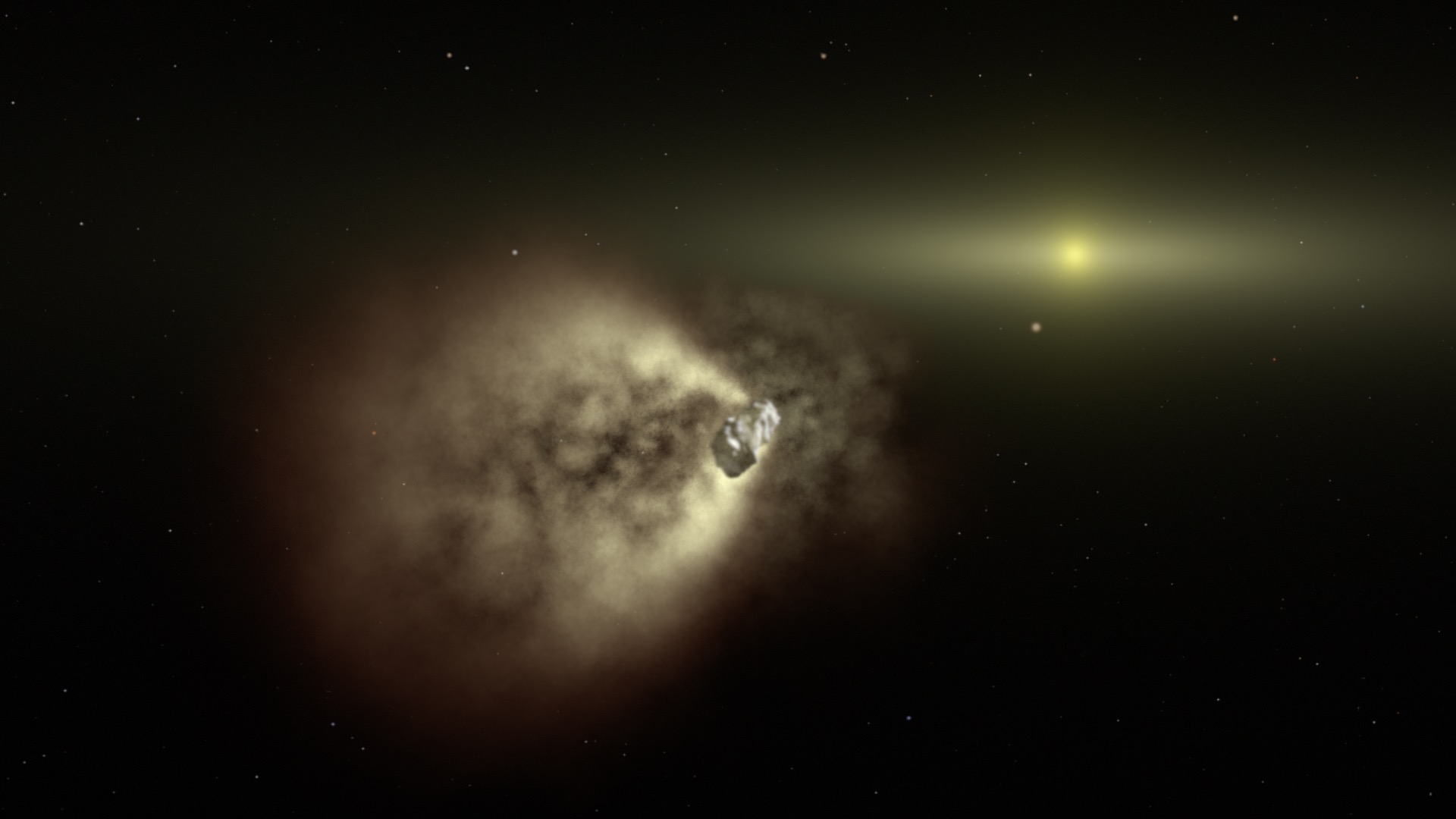Swift and Hubble Probe an Asteroid Crash
Late last year, astronomers noticed that an asteroid named Scheila had unexpectedly brightened and it was sporting short-lived plumes. Data from NASA's Swift satellite and Hubble Space Telescope show that these changes likely occurred after Scheila was struck by a much smaller asteroid.
On Dec. 11, 2010, images from the University of Arizona's Catalina Sky Survey, a project of NASA's Near Earth Object Observations Program, revealed the Scheila to be twice as bright as expected and immersed in a faint comet-like glow. Looking through the survey's archived images, astronomers inferred the outburst began between Nov. 11 and Dec. 3.
Three days after the outburst was announced, Swift's Ultraviolet/Optical Telescope (UVOT) captured multiple images and a spectrum of the asteroid. Ultraviolet sunlight breaks up the gas molecules surrounding comets; water, for example, is transformed into hydroxyl (OH) and hydrogen (H). But none of the emissions most commonly identified in comets — such as hydroxyl or cyanogen (CN) — show up in the UVOT spectrum. The absence of gas around Scheila led the Swift team to reject scenarios where exposed ice accounted for the activity.
Images show the asteroid was flanked in the north by a bright dust plume and in the south by a fainter one. The dual plumes formed as small dust particles excavated by the impact were pushed away from the asteroid by sunlight. Hubble observed the asteroid's fading dust cloud on Dec. 27, 2010, and Jan. 4, 2011.
The two teams found the observations were best explained by a collision with a small asteroid impacting Scheila's surface at an angle of less than 30 degrees, leaving a crater 1,000 feet across. Laboratory experiments show a more direct strike probably wouldn't have produced two distinct dust plumes. The researchers estimated the crash ejected more than 660,000 tons of dust—equivalent to nearly twice the mass of the Empire State Building.
For the collision animation go to #10759.
Short narrated video about the asteroid collision.
Star Wars: Episode V - The Empire Strikes Back™ & © 1980 and 1997 Lucasfilm Ltd. All rights reserved. Used under authorization. COURTESY OF LUCASFILM LTD.
For complete transcript, click here.

Faint dust plumes bookend asteroid (596) Scheila, which is overexposed in this composite. Visible and ultraviolet images from Swift's UVOT (circled) are merged with a Digital Sky Survey image of the same region. The UVOT images were acquired on Dec. 15, 2010, when the asteroid was about 232 million miles from Earth.
Credit: NASA/Swift/DSS/D. Bodewits (UMD)

Faint dust plumes bookend asteroid (596) Scheila, which is overexposed in this composite. Visible and ultraviolet images from Swift's UVOT (circled) are merged with a Digital Sky Survey image of the same region. The UVOT images were acquired on Dec. 15, 2010, when the asteroid was about 232 million miles from Earth. Labeled.
Credit: NASA/Swift/DSS/D. Bodewits (UMD)

The Hubble Space Telescope imaged (596) Scheila on Dec. 27, 2010, when the asteroid was about 218 million miles away. Scheila is overexposed in this image to reveal the faint dust features. The asteroid is surrounded by a C-shaped cloud of particles and displays a linear dust tail in this visible-light picture acquired by Hubble's Wide Field Camera 3. Because Hubble tracked the asteroid during the exposure, star images are trailed.
Credit: NASA, ESA, and D. Jewitt (UCLA)

The Hubble Space Telescope imaged (596) Scheila on Dec. 27, 2010, when the asteroid was about 218 million miles away. Scheila is overexposed in this image to reveal the faint dust features. The asteroid is surrounded by a C-shaped cloud of particles and displays a linear dust tail in this visible-light picture acquired by Hubble's Wide Field Camera 3. Because Hubble tracked the asteroid during the exposure, star images are trailed. Labeled.
Credit: NASA, ESA, and D. Jewitt (UCLA)

Print resolution image from collision animation.
Credit: NASA/Goddard Space Flight Center/Conceptual Image Lab
For More Information
Credits
Please give credit for this item to:
NASA/Goddard Space Flight Center. However, each image should be credited as indicated above.
-
Animators
- Michael Lentz (UMBC)
- Walt Feimer (HTSI)
- Scott Wiessinger (UMBC)
- Chris Smith (HTSI)
- Jake Dean (Aloe Design Studios)
- Chris Meaney (HTSI)
-
Video editor
- Scott Wiessinger (UMBC)
-
Narrator
- Scott Wiessinger (UMBC)
-
Producer
- Scott Wiessinger (UMBC)
-
Scientist
- Dennis Bodewits (University of Maryland College Park)
-
Writers
- Francis Reddy (SPSYS)
- Scott Wiessinger (UMBC)
Release date
This page was originally published on Thursday, April 28, 2011.
This page was last updated on Wednesday, May 3, 2023 at 1:53 PM EDT.
Missions
This visualization is related to the following missions:Series
This visualization can be found in the following series:Tapes
This visualization originally appeared on the following tapes:-
Swift Asteroid Collision
(ID: 2011041)
Thursday, April 28, 2011 at 4:00AM
Produced by - Robert Crippen (NASA)
Papers used in this visualization
Datasets used in this visualization
-
[HST]
ID: 36 -
[Swift]
ID: 217
Note: While we identify the data sets used in these visualizations, we do not store any further details, nor the data sets themselves on our site.
